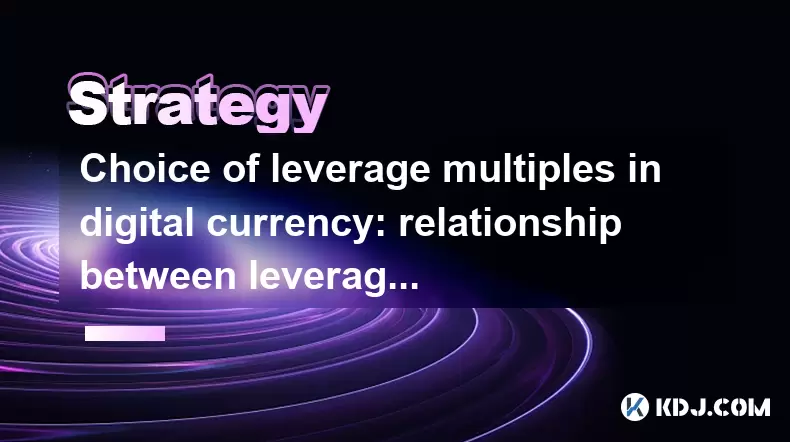-
 bitcoin
bitcoin $114320.977035 USD
-0.40% -
 ethereum
ethereum $4152.439985 USD
-1.75% -
 tether
tether $1.000111 USD
-0.04% -
 xrp
xrp $2.843037 USD
-1.63% -
 bnb
bnb $1013.349380 USD
-1.62% -
 solana
solana $208.362767 USD
-2.10% -
 usd-coin
usd-coin $0.999783 USD
0.00% -
 dogecoin
dogecoin $0.232559 USD
-1.00% -
 tron
tron $0.333491 USD
-1.09% -
 cardano
cardano $0.806310 USD
0.19% -
 hyperliquid
hyperliquid $45.023720 USD
-1.59% -
 ethena-usde
ethena-usde $1.000819 USD
-0.06% -
 chainlink
chainlink $21.241249 USD
-2.11% -
 avalanche
avalanche $30.035416 USD
-0.66% -
 stellar
stellar $0.364984 USD
-2.05%
Choice of leverage multiples in digital currency: relationship between leverage ratio and risk
Leverage in crypto trading amplifies both potential returns and risks; choosing the right multiple depends on market volatility, experience, and risk tolerance.
Jun 10, 2025 at 03:57 pm

The choice of leverage multiples in the world of digital currency trading is a critical decision that directly impacts the potential returns and risks associated with each trade. Leverage, in the context of cryptocurrency trading, refers to the use of borrowed funds to increase the potential return on an investment. While leverage can amplify profits, it also significantly increases the risk of substantial losses. Understanding the relationship between leverage ratios and risk is essential for traders looking to navigate the volatile crypto markets effectively.
Understanding Leverage in Cryptocurrency Trading
Leverage allows traders to control larger positions than their initial capital would permit. For instance, with a leverage ratio of 10:1, a trader can control a position worth $10,000 with just $1,000 of their own money. The higher the leverage ratio, the smaller the amount of capital required to open a position. However, this also means that even small market movements can lead to significant gains or losses.
The Impact of Leverage on Risk
The primary factor to consider when choosing a leverage multiple is the impact on risk. Higher leverage ratios increase the potential for both gains and losses. A small adverse price movement can quickly wipe out a trader's initial investment when using high leverage. For example, if a trader uses 100:1 leverage and the market moves against them by just 1%, they could lose their entire investment.
Conversely, lower leverage ratios reduce the risk of significant losses but also limit the potential for substantial gains. A trader using 2:1 leverage, for instance, would need a much larger price movement to achieve the same level of profit as a trader using 100:1 leverage. However, the risk of a total loss is also much lower with lower leverage.
Factors to Consider When Choosing Leverage Multiples
When deciding on the appropriate leverage multiple, traders should consider several key factors:
- Market Volatility: Highly volatile markets may require lower leverage to mitigate risk. Cryptocurrencies are known for their volatility, so understanding the current market conditions is crucial.
- Trading Experience: Novice traders may want to start with lower leverage to gain experience without risking significant losses. More experienced traders might be comfortable with higher leverage.
- Risk Tolerance: Traders with a higher risk tolerance might opt for higher leverage, while those with a lower risk tolerance should stick to lower multiples.
- Position Size: The size of the position relative to the trader's overall portfolio can influence the choice of leverage. Larger positions might warrant lower leverage to manage risk.
Strategies for Managing Risk with Leverage
Effective risk management is essential when using leverage in cryptocurrency trading. Here are some strategies to consider:
- Stop-Loss Orders: Using stop-loss orders can help limit potential losses by automatically closing a position when the market moves against it. Setting a stop-loss at a reasonable level can prevent a small loss from turning into a significant one.
- Position Sizing: Adjusting the size of the position based on the chosen leverage can help manage risk. Smaller positions with higher leverage or larger positions with lower leverage can be used depending on the trader's risk tolerance.
- Diversification: Spreading investments across different cryptocurrencies can reduce the risk associated with any single asset. Diversification can help mitigate the impact of adverse price movements on the overall portfolio.
- Regular Monitoring: Keeping a close eye on market conditions and adjusting positions accordingly can help manage risk. Active monitoring allows traders to respond quickly to market changes and adjust their leverage as needed.
Practical Examples of Leverage and Risk
To illustrate the relationship between leverage and risk, consider the following examples:
- Example 1: A trader uses 10:1 leverage to open a $10,000 position with $1,000 of their own money. If the price of the cryptocurrency increases by 5%, the trader's profit would be $500 (5% of $10,000), resulting in a 50% return on their initial investment. However, if the price decreases by 5%, the trader would lose $500, wiping out half of their initial investment.
- Example 2: Another trader uses 50:1 leverage to open a $50,000 position with the same $1,000. A 1% increase in the price would yield a $500 profit, a 50% return on the initial investment. However, a 1% decrease would result in a $500 loss, completely wiping out the initial investment.
These examples demonstrate how higher leverage can lead to higher returns but also higher risk of significant losses.
Choosing the Right Leverage Multiple
Choosing the right leverage multiple depends on a trader's individual circumstances and trading goals. There is no one-size-fits-all answer, as the optimal leverage ratio varies based on market conditions, trading experience, and risk tolerance. Traders should carefully assess these factors and consider their overall trading strategy when deciding on the appropriate leverage multiple.
Frequently Asked Questions
Q1: Can leverage be adjusted during an open position?A1: Yes, many trading platforms allow traders to adjust leverage on open positions. This can be useful for managing risk as market conditions change. However, traders should be aware that adjusting leverage may affect the margin requirements and potential liquidation levels.
Q2: What is the difference between margin and leverage?A2: Margin is the amount of capital required to open a leveraged position, while leverage is the ratio of the position size to the margin. For example, with 10:1 leverage, a trader might need to provide 10% of the position size as margin.
Q3: Are there any regulations on leverage in cryptocurrency trading?A3: Regulations on leverage vary by jurisdiction. Some countries have strict rules on the maximum leverage that can be offered to retail traders, while others have more lenient regulations. It's important for traders to be aware of the regulatory environment in their region.
Q4: How does leverage affect liquidation levels?A4: Leverage directly impacts the liquidation levels of a position. Higher leverage means that smaller adverse price movements can trigger liquidation, as the margin required to maintain the position is smaller relative to the position size. Traders should carefully monitor their positions and ensure they have sufficient margin to avoid liquidation.
Disclaimer:info@kdj.com
The information provided is not trading advice. kdj.com does not assume any responsibility for any investments made based on the information provided in this article. Cryptocurrencies are highly volatile and it is highly recommended that you invest with caution after thorough research!
If you believe that the content used on this website infringes your copyright, please contact us immediately (info@kdj.com) and we will delete it promptly.
- BlockDAG, DOGE, HYPE Sponsorship: Crypto Trends Shaping 2025
- 2025-10-01 00:25:13
- Deutsche Börse and Circle: A StableCoin Adoption Powerhouse in Europe
- 2025-10-01 00:25:13
- BlockDAG's Presale Buzz: Is It the Crypto to Watch in October 2025?
- 2025-10-01 00:30:13
- Bitcoin, Crypto, and IQ: When Genius Meets Digital Gold?
- 2025-10-01 00:30:13
- Stablecoins, American Innovation, and Wallet Tokens: The Next Frontier
- 2025-10-01 00:35:12
- NBU, Coins, and Crypto in Ukraine: A New Yorker's Take
- 2025-10-01 00:45:14
Related knowledge

Practical parameter settings for a Bitcoin multi-timeframe moving average system
Sep 18,2025 at 10:54pm
Optimizing Timeframe Combinations for Bitcoin Trading1. Selecting appropriate timeframes is crucial when building a multi-timeframe moving average sys...

How can I filter out false breakouts in Dogecoin high-frequency trading?
Sep 22,2025 at 01:00am
Understanding False Breakouts in Dogecoin Trading1. A false breakout occurs when Dogecoin's price appears to move beyond a defined support or resistan...

Techniques for identifying tops and bottoms in the Bitcoin on-chain NVT model
Sep 20,2025 at 07:54pm
Understanding the NVT Model in Bitcoin Analysis1. The Network Value to Transactions (NVT) ratio is often described as the 'P/E ratio' of the cryptocur...

What does the surge in open interest in Bitcoincoin futures mean?
Sep 20,2025 at 11:18pm
Understanding the Surge in Dogecoin Futures Open Interest1. A surge in open interest within Dogecoin futures indicates a growing number of active cont...

How can I use the Ethereum USDT premium to gauge market sentiment?
Sep 18,2025 at 11:55pm
Understanding the Ethereum USDT Premium1. The Ethereum USDT premium refers to the price difference between USDT (Tether) traded on Ethereum-based plat...

What should I do if Ethereum staking yields decline?
Sep 20,2025 at 06:18am
Understanding the Causes Behind Declining Ethereum Staking Yields1. The Ethereum network transitioned to a proof-of-stake consensus mechanism with the...

Practical parameter settings for a Bitcoin multi-timeframe moving average system
Sep 18,2025 at 10:54pm
Optimizing Timeframe Combinations for Bitcoin Trading1. Selecting appropriate timeframes is crucial when building a multi-timeframe moving average sys...

How can I filter out false breakouts in Dogecoin high-frequency trading?
Sep 22,2025 at 01:00am
Understanding False Breakouts in Dogecoin Trading1. A false breakout occurs when Dogecoin's price appears to move beyond a defined support or resistan...

Techniques for identifying tops and bottoms in the Bitcoin on-chain NVT model
Sep 20,2025 at 07:54pm
Understanding the NVT Model in Bitcoin Analysis1. The Network Value to Transactions (NVT) ratio is often described as the 'P/E ratio' of the cryptocur...

What does the surge in open interest in Bitcoincoin futures mean?
Sep 20,2025 at 11:18pm
Understanding the Surge in Dogecoin Futures Open Interest1. A surge in open interest within Dogecoin futures indicates a growing number of active cont...

How can I use the Ethereum USDT premium to gauge market sentiment?
Sep 18,2025 at 11:55pm
Understanding the Ethereum USDT Premium1. The Ethereum USDT premium refers to the price difference between USDT (Tether) traded on Ethereum-based plat...

What should I do if Ethereum staking yields decline?
Sep 20,2025 at 06:18am
Understanding the Causes Behind Declining Ethereum Staking Yields1. The Ethereum network transitioned to a proof-of-stake consensus mechanism with the...
See all articles










































































